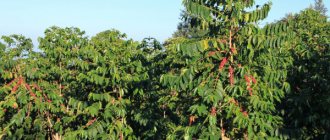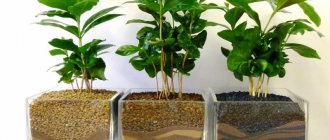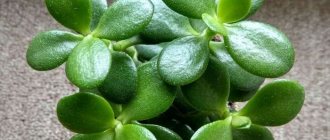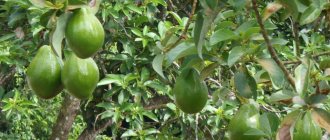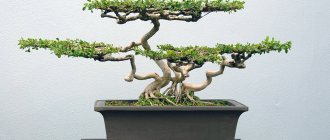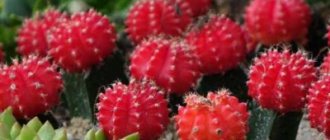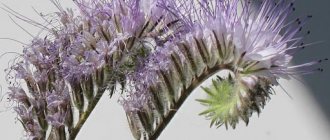This time we are sharing secrets on how to grow a coffee tree from a grain (seed) or cutting. This fragrant plant will become an exotic decoration for your home greenhouse. It is grown as a decorative element or for its fruit. The shape of the plant resembles a low bush. It is regularly trimmed and fed with mineral preparations. In comfortable conditions and proper care, about 500 g of fruits are collected from one tree.
Where are the plantations?
Coffee plantations are located in equatorial countries. The trees grow on the African continent, Madagascar, Central and South America, southeast Asia, and Australia.
Coffee trees do not do well in the constant heat of tropical climates. Therefore, they are planted on high mountain slopes with soil of volcanic origin. The optimal height is 1-2.5 thousand m above sea level.
Exposure to the scorching sun is detrimental to plantations. Therefore, in addition to coffee plants, tall trees with a dense crown are planted. Read more in the article “Where Coffee Really Grows.”
Where to put the plant
A young indoor coffee tree requires a lot of light, so it is best to place the pot on a windowsill in a warm room. Coffee also grows well on a north-facing window, but a south-facing window is best suited for it. One of the most important requirements is not to change the location of the plant and not to rotate the pot. This will cause foliage to fall, and the flowering tree may lose its buds and subsequently fail to bear fruit.
Main types of trees
Arabian
The variety is used in coffee growing as an ornamental plant. The tree has oblong dark olive leaves with a glossy surface. Their size reaches 30 cm.
If the tree is grown indoors, it is regularly trimmed so that it does not rest against the ceiling. The optimal height is 1.4 meters. On plantations this variety grows up to 5 meters.
Flowers appear only in the 4th year of life. The tree begins to produce its best harvest at 7-8 years of age.
The Arabian tree grows actively in spring and summer. Every year it grows by 8-10 cm.
Dwarf nana
This tree grows only up to 1 meter, so it is suitable for apartments and private houses. Dwarf nana blooms profusely and is unpretentious to its conditions. Leaves with light veins grow up to 15 cm.
The crown is trimmed annually to give the coffee tree a decorative appearance.
Small white flowers develop into terracotta-colored fruits. During the season, up to 0.5 kg of fruits are collected from dwarf nana.
The tree grows well in high humidity and does not tolerate drafts.
Liberian
Due to its size, this variety is rarely used for growing indoors. At home, the coffee tree reaches 4 meters and feels good on the windowsill.
The crown has to be trimmed constantly. Otherwise, the leaves will prop up the ceiling and the plant will lose its decorative effect.
Feeding
For normal growth, flowering and fruiting, the plant should be regularly fed with organic and mineral fertilizers. This is especially true for the period of active growth in spring and summer. You can alternate types of fertilizers, increasing the dose of nitrogen in the spring, giving a full mineral complex during flowering, and phosphorus for fruit formation. The time of relative peace is winter. Potassium can be given for maintenance.
The domestic coffee tree blooms with very delicate white inflorescences, consisting of many flowers with pointed petals. The fragrance permeates the entire apartment. In the absence of natural pollination assistants, bees, this can be done manually by lightly shaking the flowering branches or walking over the inflorescences with a soft brush.
Coffee flowers are very beautiful and fragrant
Coffee varieties
Arabica
The most common variety of coffee tree.
The plant is demanding to care for, needs diffused sunlight and moderate moisture.
In nature, the tree grows up to 10 meters. But for convenient collection of beans it is cut to 4 meters
Arabica does not tolerate cold. Therefore, the tree is grown at a temperature of at least 15 degrees Celsius.
The Arabica drink has a sour taste. The bean contains 1.5% caffeine.
Robusta
The Robusta coffee variety is unpretentious in terms of content. It grows at temperatures down to 0 degrees and tolerates heat well. Another advantage is resistance to pests.
Interesting! How to grow a coffee tree at home from coffee beans
Up to 1.5 kg of beans are collected from one tree (0.9 kg from Arabica).
Robusta has a pronounced bitter taste. Therefore, grains of this variety are added to mixtures. Mono varieties are rare.
Robusta beans contain about 3% caffeine.
Liberica
Less popular variety due to low taste. Liberica is mainly used to make coffee blends and instant coffee. It is also used in the manufacture of confectionery products.
Of the total volume of coffee trees grown, only 2% is Liberica.
Trees do not do well in drought and high humidity. If there is prolonged bad weather, the tree stops bearing fruit.
This variety is resistant to diseases and insect pest attacks.
Liberica beans contain up to 2.4% caffeine and are three times longer than Arabica beans.
Excelsa
Excelsa is a type of liberica. It easily tolerates heat and high humidity, but is demanding on the composition of the soil. This variety needs moist soil with a rich organic composition.
The trees reach a height of 20 meters.
The brewed drink has a fruity smell and a chocolate-nut taste with hints of sourness. Excelsa is added to elite coffee varieties.
One bean contains up to 1.5% caffeine.
Tree in the house
The bush form of coffee, which can be grown and maintained in good condition for many years, has the appearance of a compact, heavily leafy plant. It is the large amount of greenery, as well as the aroma of blooming buds, that is the main advantage of the tree. A low-growing Arabica variety is suitable for growing at home. Robusta simply won’t fit in your apartment, and it requires cross-pollination to bear fruit.
The bush, which quickly grows in length and width, is quite suitable for artificial formation. You can give it the shape of a real tree with a woody trunk and a compact rounded crown.
Bearing in mind what a riot of plants can be found in a small area of any tropical region, you can count on good compatibility of the coffee tree, in terms of proximity, with ordinary indoor flowers. You just need to take care of good lighting. Coffee is photophilous, but does not tolerate direct rays of the sun. And he doesn’t really approve of frequent changes. The side facing the windows of the room with a coffee tree must certainly have a southern orientation. But light shading is still necessary. If you decide to move the pot from corner to corner or often take the plant out to “breathe” on the balcony on a fine summer day, this can have a beneficial effect on the crown. It will be smooth and thick. But in this case, you won’t expect flowers that emit an incredibly delicate aroma and, especially, valuable beans for the “production” of exclusive homemade coffee. That is, it is better to choose a permanent place.
Caring for a home coffee tree is easy
Soil preparation
You can only grow coffee at home in suitable soil. The optimal composition is perlite and peat.
A mixture of river sand, ground peat and leaf turf in proportions of 2:2:1 is also suitable. Or an equal amount of humus, leaf turf, sand, black soil and two parts of acidic peat.
Mix the ingredients in the required proportions and pour into a small container.
Do not compact the soil too hard. It must be loose so that air gets to the root system.
Add finely chopped sphagnum moss. It retains moisture and maintains soil acidity.
Be sure to install drainage at the bottom of the pot. When loose soil is watered, the water moisturizes the roots well and does not stagnate. The excess will drain into the pan, so the roots will not rot if there is excessive moisture.
Before planting the cuttings, the soil is disinfected with a weak solution of potassium permanganate.
Propagation of a coffee tree by cuttings
It is easier to propagate plants using green cuttings. To do this, you need to prepare a soil mixture of equal parts of acidic marsh crumbs based on peat and perlite. It will allow oxygen and moisture to pass through well. It is also necessary to disinfect the soil with a manganese solution.
The most optimal temperature for rooting is +25-30 degrees with high air humidity. The main sign that the cuttings have taken root is the growth of the upper buds. And when a new pair of leaves appears, you can transplant them into a separate container.
Cuttings have a number of advantages:
You can buy a young plant at a flower shop. Its cost will depend on the type, height and diameter of the pot. For example, the average price of a small specimen 30 cm high in a pot with a diameter of 12 cm is approximately 1000 rubles in online stores.
Growing from cuttings
Getting ready for planting
Now let’s talk about how to grow a coffee tree from a green cutting at home.
Using a sharp knife, cut a branch from the middle of the crown of an adult coffee tree 3 cm below the leaves. Take a cutting with flower bud embryos. Such a plant will begin to branch and bloom faster.
On the trunk, under the two outer leaves, make longitudinal scratches so that the roots form faster.
For better growth, the cuttings are first left for 3-4 hours in a growth stimulator. A heteroauxin solution is suitable. Dissolve 1/4 tablet of the drug in 1.5 liters of water. But do not submerge the branch completely. It is enough to lower it by 1-1.5 cm.
Heteroauxin can be replaced with indolyl-3-butyric acid. 25 ml of the drug is diluted in 0.5 liters of water. The cuttings are immersed 1 cm and left in the solution for 16 hours.
A solution of 1 tsp is also suitable. honey and 200 ml warm water.
The twig is soaked and then planted in a small container with prepared soil.
To keep the soil always moist, create a greenhouse effect using a plastic bag. Make holes in it for air access.
Transplant into a pot
The cuttings are transplanted into a permanent pot after new leaves have formed. At this moment, the plant begins to form a root system.
Interesting! How many spoons of coffee should I put in a cup?
The optimal humidity for rooting is 75-80%, temperature is 28-30 degrees Celsius.
After transplanting, water the plant and keep an eye on it. If the cutting has taken root, after 2 weeks move the pot to a permanent place.
A coffee tree grown from a cutting begins to bear fruit within a year after planting.
How to replant a coffee tree
In order for the plant to actively grow and bloom in the future, it must be replanted annually in a larger pot. Without this stage of care, it will develop poorly.
When the tree reaches three years of age, replanting can be done every two years.
The best time to transplant a coffee tree is March or April.
Prepare a new container for replanting with fresh soil. The pot should not be much larger than before. It is enough for there to be a distance of 3-4 centimeters from the root system. Otherwise, the soil will quickly deteriorate, which will lead to rotting of the roots.
Carefully remove the bush from the old pot. Before planting it in a new one, carefully inspect the root system of the plant. Some roots may be dried out or show signs of rot. They need to be trimmed. Next, plant the plant in a new pot. Its root collar - a place about 2-3 centimeters above the uppermost lateral root - should protrude from the substrate by about half a centimeter.
Fill the voids left during replanting with soil. Then water well with water at room temperature. After a couple of days, we loosened the soil so that moisture did not stagnate in the roots.
You should not plant a coffee tree outside even in the summer. Our climate is not suitable for a tropical plant; with a high degree of probability it will die.
How coffee beans are grown
We recommend growing the tree from fresh seeds. They grow in 95% of cases. If the beans have been stored for several months, the chances drop to 2-3%.
Make a deep cut in the outer shell of the seed to help it germinate faster.
Before planting the coffee bean, put it in a growth stimulator overnight (we talked about them above). And in the morning, plant the seeds in loosened, slightly moist soil to a depth of 4 cm. The distance between the seeds should be 3 cm.
Water the soil with cool water and cover with a jar or plastic to create a greenhouse effect. Place the pot in a warm place.
Every two weeks, open the pot and remove any condensation. After 1-1.5 months, the planted seed will hatch and the sprouts can be transplanted into separate containers.
After a month, the coffee seeds are transplanted into a larger container.
A tree made from grains will bloom only 2-2.5 years after planting. The first grains will appear after 4 years.
Flowering period
4 years after planting the coffee bean, the first flowers will appear on the carefully cared for tree. The flowering period begins in spring. At this time, beautiful white flowers appear on the branches, spreading a pleasant aroma similar to jasmine.
After some time, small green-colored fruits begin to set. Gradually they change it to a rich burgundy. Each fruit contains two coffee beans. At home, their ripening period lasts up to two years, ripeness is determined by color.
Some gardeners recommend shaking the tree slightly during flowering to help it pollinate.
Tree care
Temperature and light
The coffee tree does not tolerate the lack of sunny color. The trunk will be overgrown with a lush green crown, but will not bear fruit.
The ideal place is a windowsill. Choose the south or east side. On the north window the tree grows slowly.
Due to constant exposure to sunlight, burns may appear on the leaves. When fruit appears, shade the plant with a curtain or fence.
In winter, eliminate drafts and seal cracks in windows.
The temperature should not fall below 15 degrees and exceed 25 degrees.
Watering
Water the coffee on the windowsill with settled water at 20-25 degrees.
In summer, the soil dries out quickly, so you need to water it every day. In winter, the plant is watered once a week.
Do not flood the growing plant with water. If dark spots appear on the leaves, reduce the amount of watering. Dry ends indicate lack of water and low humidity.
Pour 3-4 drops of apple cider vinegar into your water every month. This will keep the soil acidic for rapid plant growth.
Twice a week, spray the tree with cool water from a spray bottle and wipe the leaves with a damp cloth.
Once every 1-1.5 months, give the coffee tree a warm shower. But the pressure should not be strong.
Top dressing
When growing coffee at home, fertilizers are used. From April to September, during flowering, mineral supplements are added every 15 days.
Use complex preparations for decorative foliage plants. An infusion of cow manure or chicken manure is also suitable.
Fill half a bucket with barn or chicken excrement. Pour cool water to the top, stir well. Cover the bucket with a lid and leave to ferment for 2 weeks.
Then dilute the fertilizer with water in a 1:1 ratio and water the plant.
In late autumn and winter, the tree is not fed. It is at rest and resting.
Once every 1-1.5 months you can enrich the soil with liquid potassium for nutrition. Highly concentrated potassium sulfate fertilizer is suitable.
Do not exceed the dosage indicated in the instructions. Excessive amounts of fertilizer will harm the plant.
Transfer
When growing coffee, the tree is transplanted into a larger pot every March-April.
Interesting! How to grow Arabic coffee in a room - characteristics of the plant, and methods
After four years, the active growth of the plant slows down. Transplantation is carried out no more than once every 2-3 years.
Each time the diameter and size of the pot increase. Let's look at examples:
- a tree 40 cm tall is planted in a container 25 cm high and 24 cm in diameter;
- 50 cm - 35 cm by 35 cm, respectively;
- 100 cm - 60 cm by 60 cm.
Do not plant the tree in a low pot like a bonsai. The root system will be crowded.
Trimming
Domestic trees have to be pruned. Otherwise they will grow too tall and will prop up the ceiling.
Dry and weakened branches that shed leaves are also pruned. They only slow down the growth of the tree.
Typically, crown pruning is carried out only at the 8-9th year of the plant’s life.
Problems in growing coffee and their solutions
Leaves begin to turn yellow or their tips dry out
The air in the room is too dry - the humidity needs to be increased. There are different ways: installing a humidifier, frequently spraying the plant, decorative bowls with wet pebbles, placing the plant on a tray with wet gravel or expanded clay, etc. Also, the leaves acquire a yellowish tint due to iron deficiency.
young coffee shoot
Dry blackish spots appear on coffee leaves
Most likely, the plant does not have enough moisture. The soil should be light, acidic, moisture- and breathable. The coffee should be watered and sprayed with warm water, generously in summer, immediately after the soil in the pot has dried, in winter – moderately, not immediately after the soil has dried, but a day or two later.
Soft dark brown spots appear on coffee leaves and they are expanding
Coffee does not tolerate not only dryness, but also waterlogging. If the spots occupy an increasingly larger area, then most likely the roots have begun to rot. In this case, the root system is inspected, and if the roots are rotten, they are cut back to healthy tissue (sometimes to half of all roots), treated with a fungicide and replanted in fresh soil. Then they put it in a microgreenhouse for resuscitation: there are few roots, the leaves continue to evaporate water, and it is necessary to create increased air humidity for the plant. If the roots are still slightly damaged, they are slightly shortened, the plant is replanted in fresh soil and cared for, paying special attention to watering: it should be slightly less than usual.
young coffee plant
The lower leaves of the coffee are turning yellow
If there is a gradual, slow yellowing of the lower leaves, one at a time, this is a natural aging process. Massive yellowing and falling of the lower leaves is a sign of plant starvation. About fertilizing, see below.
All the coffee leaves suddenly began to turn yellow
The plant experiences stress from sudden temperature changes. Coffee does not tolerate drafts.
The edges of the leaves are uneven and turn brown.
This may indicate a lack of mineral nutrition, particularly potassium. To prevent this from happening, coffee is fed with complex fertilizer with microelements 2 times a month. In winter, plants are not fertilized or fed once a month with solutions of lower concentration.
Diseases and pests
Reasons for appearance
When attacked by pests, the tree begins to wither. The plant is not protected from them even indoors. The ends of the leaves darken and holes form on them.
The reasons for the appearance of insects are poor-quality soil and dirty equipment. Pests fly into the apartment through windows, cracks, and ventilation holes.
Spider mite
The most common insect is the spider mite. It can completely destroy the plant.
Tiny insects cling to the undersides of the leaves. They are noticeable even with the naked eye.
In the early stage, the leaves become covered with small holes. The plant is then entangled in a web.
Optimal conditions for ticks are low humidity and sunny weather.
The tree is sprayed with a cool solution of organic soap 3-4 times a day. Chemicals are used every three days:
- "Neoron";
- "Fitoverm";
- "Anti-mite."
When processing, do not allow drugs to come into contact with the fruits.
Aphid
When attacked by aphids, the leaves of the tree curl. Tiny punctures with a diameter of 2 mm and a transparent trace of pest secretions appear on them. They pierce the leaves and suck out the juice.
Aphids breed in dry and warm rooms. If pests are found, wipe each leaf of the plant with a piece of foam rubber soaked in a soap solution.
If there are too many affected leaves, treat the tree with chemicals - Atorin, Aktara.
Aphids quickly adapt to the composition, so do not use the same preparation twice.
Whiteflies
Tiny white insects live under the top leaves of the tree. They slow down the production of chlorophyll and stop plant growth. A sugary stain appears on the leaves, whiteflies and their larvae are visible.
It is very difficult to get rid of the larvae. They are not affected by purchased chemicals and homemade poisons.
If the leaf is half affected, it will have to be cut off. The plant is treated with a soap solution, garlic infusion, and dichlorvos.
Coffee tree diseases
The main reason for plant diseases is improper care. Coffee tree diseases can be eliminated as follows:
Now you know how to care for a coffee tree. If you do everything correctly, then in 3-4 years you will be able to get not only a beautiful indoor plant, but fruits in the form of berries from which grains are extracted. When processed, you get real natural coffee. And when grown from cuttings, the tree can begin to bear fruit in the first year.
Growing indoors
The soil
The coffee tree has long roots that penetrate deep into the soil. Therefore, the soil must be breathable and contain a large amount of humus and peat. You can also add bone meal to the soil. The soil type should be slightly acidic with a pH level of around 6.
Fertilizer
When preparing the soil for planting and over the next two months, it is necessary to feed the crop with 100 mg of fertilizer for citrus plants. From April to the end of August or during the growing season, granular fertilizers should be applied regularly (every month).
Crops that prefer acidic soil often suffer from iron deficiency. Therefore, it is better to use the supplement with the component once a year.
Coffee pot
You should choose a deep pot with good drainage. A plastic container works much better than a clay container.
It is advisable to keep the flowerpot in the eastern or western part of the building. The pot with the plant must be placed in a warm and humid place without drafts or wind.
You can learn the features of growing on a windowsill from the video:
Delicious coffee at home. Cup
Coffee is simply poured with hot water, infused, and after that you can try it. Zhenya says there are several very important points. Most people just pour water on their coffee and don’t understand what to do next. An experienced barista explains.
— For 250 ml of water we need 15 g of coffee. There are scales in almost every kitchen. If not, you can learn to measure with a spoon. I have advanced scales, so they also record time, and we also need this, because coffee is brewed according to time.
Zhenya advises having one at home, because ground but aged coffee is no match for fresh coffee. For this brewing method (an alternative name is Warsaw-style coffee), we grind the beans quite coarsely - approximately to the size of sugar particles, not into flour.
— Professional coffee tasters engage in so-called cupping. This is the actual taste testing process. So, when we brew coffee in a mug, it gives off the maximum amount of coffee. This is the clearest way to evaluate the quality and potential of coffee. Aeropress, French press, coffee machine, Turk, geyser change the taste a little. This is fine. But the cup reveals the grains better than anyone else.
As a result, the ground coffee is sent into a cup, after which it is filled with water. What's important here? The water should not be boiled. If not, you can bring the water to a boil and let it sit for about 30 seconds (at least). In general, we need a temperature of 92-96 degrees.
— Fill in the water and immediately turn on the time. Our task is to wet all the coffee as quickly as possible and let it stand for 4 minutes. Why specifically 4? It is generally accepted that during this time coffee manages to give the drink all the best that it has, but does not begin to give away its negative chemistry. By the way, coffee dissolves in water only 1.5%.
During these 4 minutes we do not affect the coffee in any way. At all. We don’t shake, we don’t interfere, nothing. We want a crust to form on the surface of the water - a protective layer that will allow all the processes necessary for a cool taste to occur underneath it.
- After 4 minutes, we simply remove the top crust. It is more convenient to do this with two spoons. Spoons should not be cold. First of all, we break the crust - thus stopping the brewing process. Then we scrape off this crust. We don't need perfection. The main thing is to remove the top layer. It will have an unpleasant taste in your mouth if left.
What's cool about this recipe? The drink was under the crust, so it did not cool down. For those who like hot food without going overboard, it is very, very suitable. There is no need to stir, because sediment will begin to rise from the bottom of the cup. Another advantage of this method is that as the drink cools, it will open up more and more.
Cons: The coffee is dusty. Because there is no cleaning. It also turns out vigorous, because the coffee at the bottom will continue to brew as it cools.
Characteristic
Coffee tree (Coffea) is a tall bush or tree from the Rubiaceae family. Plants from this family have the main distinctive feature - the alkaloid caffeine is present in their stems, leaves and fruits. Some species contain more of it, others in minute quantities.
The Coffee genus is one of the leaders in caffeine content. In addition, this tonic substance is present in all parts of the plant. Botanists count about 90 species that can be called coffee trees. Some of them grow as tall bushes. But most often coffee is evergreen spreading trees.
Ethiopia is considered the birthplace of the famous plant and the drink made from it. It was here that they first began to prepare an aromatic, tonic drink from fried fruits.
Coffee trees are found in the wild in Asia and Africa. The largest industrial coffee plantations today are in India, Sri Lanka and Brazil. The heat-loving plant does not grow in our latitudes, but is quite suitable for greenhouse or home cultivation.
Coffee, the cultivation of which at home provides the tree with a compact size, has a height in adulthood that does not exceed 1.5 m. Coffee branches grow in regular tiers and are most often directed horizontally. This makes it easy to form a trunk and keep the crown to a given size.
The leaves of the plant are dark green and very showy. Leathery, shiny plates grow opposite and thickly cover the vertical stems. The shape of coffee leaves can be oval or lanceolate, the tip is always pointed, and the edges have a slight waviness.
Flowering of coffee begins only from the 3rd year of life. Flower buds are formed in the axils of leaves during 1-year growth. The flowers are snow-white or cream, have 5 petals and are collected in umbrella inflorescences.
Coffee buds remain closed on the branches for about 30 days, and only then the flowers bloom completely. After the petals open, they exude a delicate, strong aroma. A bisexual crop does not require cross-pollination. The ovaries form independently inside the flower.
The fruits that appear after flowering look like yellowish, and later bright red berries. The diameter of the coffee “berry” does not exceed 1.5 cm. The fruits in appearance are very similar to ripe cherries with a slightly elongated shape. During fruiting, the stems of the coffee tree are densely covered with groups of bright berries. Under the dense skin of each of them there is juicy, sour pulp. Inside, 2 grains ripen, closely pressed to each other.
It takes at least 4 (sometimes up to 6) months for coffee to fully mature. Ripened grains do not have a pronounced smell or taste, and their color remains light cream. Coffee acquires its characteristic color and specific aroma only after roasting.
An adult tree from a plantation produces up to 3 kg of ripe grains per year. From a houseplant in the same period you can collect up to 500 g of full-fledged coffee fruits. Homemade crops should be withered, peeled and dried. The grains are then roasted and used to brew an aromatic drink according to conventional recipes.
Not all types of coffee are suitable for home cultivation. Typically the variety is selected from the Arabian or Liberian varieties. Especially popular in potted coffee is Nana, a dwarf tree, Arabica variety.
The most suitable types of coffee trees for growing at home:
| View | Tradename | Peculiarities |
| Arabian | Arabica | In the natural environment it exceeds 5 m. At home it grows to a maximum of 100 cm. |
| Congolese | Robusta | It grows quickly and does not require special care, but is distinguished by its ability to shed fruit-bearing shoots along with the leaves. |
| Liberian | Liberica | Even at home, it develops a powerful root system and has impressive growth. Suitable for cultivation in greenhouses or large winter gardens. |
Due to the characteristics of coffee development, gardeners most often choose the compact Nana variety for home cultivation. Its large, glossy leaves reach 40 cm in length, while the height of the stem rarely exceeds 80 cm. Nana coffee bears fruit well in an ordinary apartment and is decorative all year round.
